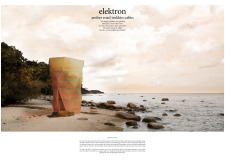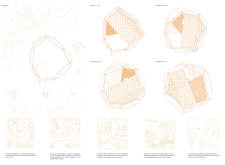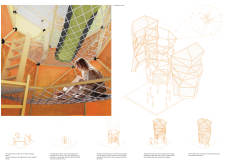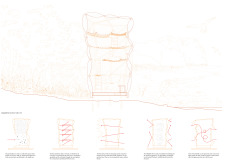5 key facts about this project
## Overview
The Amber Road Trekkin Cabin, designed by Elektron, is located along a coastal landscape, emphasizing a dialogue with its natural environment. The design is rooted in local cultural narratives, specifically the legend of the goddess Jurate, which informs both the aesthetic and functional aspects of the space. This project aims to create a retreat that balances social interaction with opportunities for personal reflection within a contemporary architectural framework.
### Spatial Configuration
The layout of the cabin is organized over multiple levels, each designated for specific functions. The ground floor serves as a communal area, fostering social gatherings through an open-plan design that encourages interaction among users. Upper levels are allocated for private sleeping quarters, featuring adaptable modular arrangements to accommodate varying group sizes. This configuration supports a communal living experience while allowing for personal privacy, reflecting a modern interpretation of integrating social and individual spaces.
### Material Innovation
A notable feature of the cabin is its innovative use of materials. The structure incorporates sustainably sourced wood for its framework, promoting an inviting atmosphere. The exterior is sheathed in an inflatable membrane, allowing for thermal insulation and flexibility while facilitating easy transportation and assembly. Interior spaces benefit from nylon netting, which offers versatile configurations, and durable metal connectors that simplify the assembly process. These choices not only enhance the cabin’s performance but also integrate ecological considerations into its design.
### Environmental Response
The cabin's design strategically incorporates large openings that connect interior spaces with the coastal landscape, enhancing user interaction with the natural environment. The ventilated skin promotes air circulation, while carefully positioned windows provide panoramic views, immersing occupants in the surrounding scenery. This relationship is further enriched through the use of transparent and translucent materials, allowing natural light to enhance the interior ambiance throughout the day, reinforcing the cabin’s connection to its environment.






















































